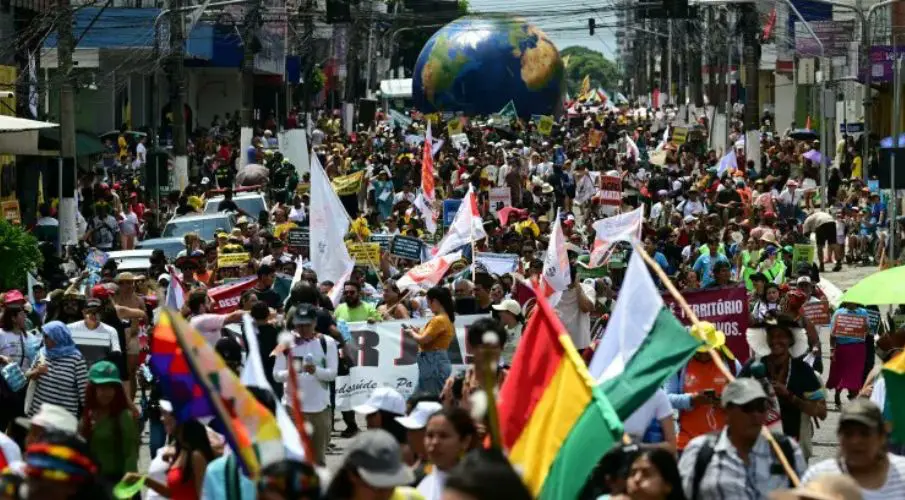Belém showed this weekend what happens when a climate summit does not take place in sterile halls but in the middle of a city that breathes, sweats and struggles. Thousands of people moved through the streets, colorful, loud and determined. They carried a giant inflatable Earth, they sang, danced, held up banners and mixed Indigenous chants with political anger. It was an image that did not only protest but warned: time is running out. Inside, in the temporary halls of COP30, the world looked different. Air conditioners failed in the humid tropical weather, rainwater dripped through the roofs and yet delegates pressed through narrow corridors, searched for outlets, drank lukewarm water and tried in this heat to negotiate global solutions. Because while the voices of the protesters grew louder outside, the bitter truth inside remained: the world is not keeping its promises.
The second week of the summit begins with a sobering assessment. Ten years after the Paris commitment to keep global warming well below two degrees, emissions are at a new record. The Earth is already 1.3 degrees warmer than in the 19th century and with today’s policies it is headed toward 2.8 degrees. These are not abstract numbers, this is the reality that pours down from the sky over Belém every afternoon in the form of brutal rainstorms.
The major heads of state and government have long since departed. Left behind are the diplomats who labor over wording that will later determine how seriously the world means business. What distinguishes Belém from recent summits is this: here, protests are allowed. And not only that – here they are permitted, protected and in some cases supported. This stands in stark contrast to the meetings in Egypt, the Emirates and Azerbaijan, where the state controlled protests with a heavy hand. In Belém, unions, Indigenous groups, climate movements and environmental organizations march side by side. The street is part of this summit and it is applying pressure.

At the center of the negotiations are two major questions: will the world finally define what a concrete exit from oil, gas and coal should look like? And will it finally provide the necessary financial resources so that poorer countries can protect themselves against floods, droughts and storms? Two years ago in Dubai, nations had only vaguely announced that they wanted to “begin” moving away from fossil fuels. But little has come from this “beginning.” That is why countries like Germany, France, Colombia, Denmark and Kenya are now pushing for a clear road map. A road map that sets out how subsidies for fossil fuels will be reduced, how states will reorganize their energy supply and how the transition can be financed. The Marshall Islands, which sit barely above sea level, put it bluntly: “We will not live if the world continues to wait.”

But the opposing forces are strong. Saudi Arabia, Russia and other major producers are blocking every attempt to impose binding limits on fossil fuels. Brazil is also caught in its own contradiction. President Lula called for determined action against fossil fuels – but only weeks earlier approved new offshore oil drilling at the mouth of the Amazon. An additional burden on the negotiations is the absence of the United States. The Trump administration has exited most international commitments and is leaving the summit to others. Without the world’s largest historical emitter, Belém is missing a voice that in earlier years moved much – for better or worse. Some delegates say openly that there is less interference without the United States. Others see a dangerous gap.

A central figure of the summit is André Corrêa do Lago, Brazil’s chief negotiator. He is trying to steer the talks toward what is essential: implementing what has long been promised. No new grand declarations but delivering on old commitments. His role becomes visible when he addresses conflicts personally. When Indigenous activists blocked the entrance on Friday, he went to them himself, spoke calmly with them for an hour, held a child in his arms and the blockade dissolved. This moment shows how close protest and diplomacy are in Belém. And how little time the world has left. Small island nations risk disappearing under the sea. Countries like Brazil feel in their own bodies how heat and rain are becoming more extreme. And everywhere the fear is growing that the negotiations will again fall short of what is needed.
Belém in these days is a magnifying glass. It shows urgency, pressure, hope – and the danger that once again everything will come too late. While drums, chants and the smell of rain fill the air outside, a tired and overheated global community struggles inside for decisions that should have been made long ago. And that is exactly the situation: the world needs decisions.
Investigative journalism requires courage, conviction – and your support.
Please help strengthen our journalistic fight against right-wing populism and human rights violations. Every investigative report, every piece of documentation, every day and every night – all of it requires time, research and legal protection. We do not rely on advertising or corporations, but solely on people who make independent journalism possible. People like you.
Not everyone can give the same amount. But everyone can make a difference. Every contribution protects a piece of journalistic independence.
Updates – Kaizen News Brief
All current curated daily updates can be found in the Kaizen News Brief.
To the Kaizen News Brief In English